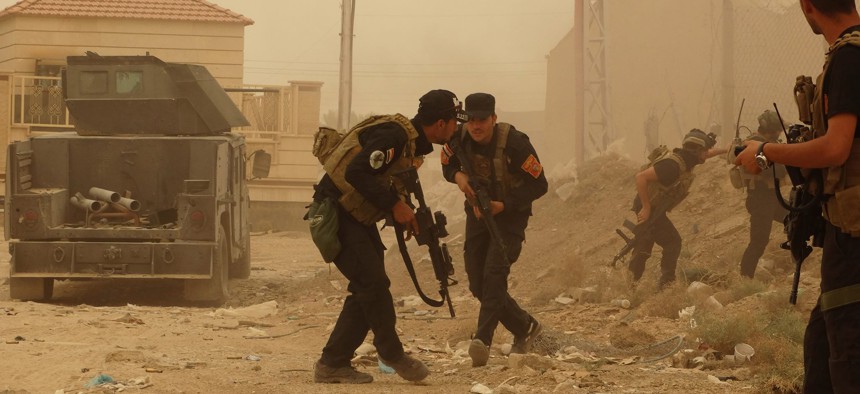
Security forces defend their headquarters against attacks by Islamic State extremists during sand storm in the eastern part of Ramadi, the capital of Anbar province, 115 kilometers (70 miles) west of Baghdad, Iraq, Thursday, May 14, 2015. AP Photo
How the Air Campaign Against ISIS Is Changing, in Three Charts
Coalition forces are going after smaller targets in missions designed to support Iraqi forces.
The air forces hitting ISIS militants in Iraq and Syria are increasingly going after smaller targets, a reflection of previous successes—and enemy adaptation.
In the past month, roughly 44 percent of air-strike targets have been towards ISIS fighting positions. That’s up from about 20 percent overall since the campaign began last summer, according to data released by the Pentagon.

Other tactical items — like ISIS vehicles, mortar positions, and the like – are being targeted more often by coalition military forces. Only 17 percent of the strikes in the past month have been targeted at buildings, down from 30 percent overall.
ISIS is providing fewer large targets for coalition strikes, said Rick Brennan, a senior political scientist at the RAND Corporation who spent five years as a senior adviser to the U.S. military in Iraq. When the airstrikes began last August, ISIS was moving larger quantities of troops and equipment, especially in northern Iraq.
“Now they’re acting much more like an insurgent group,” Brennan said. “They’re hiding, they’re moving in small groups, they’re trying to protect themselves, because they realize that if they expose themselves to aerial or visual contact to U.S. and coalition forces, they’re likely to be striked.”
Brennan said that group troops, U.S. special operations forces, for example, could help make the airstrikes more effective by increasing the communication and intelligence surrounding potential targets.
The U.S. still handles the vast majority of the strikes in both Iraq and Syria. In Syria, the U.S. conducts 94 percent of the strikes; in Iraq, 66 percent.


The operation has cost the U.S. $2.11 billion since Aug. 8, or $8.6 million per day, according to the Pentagon.




